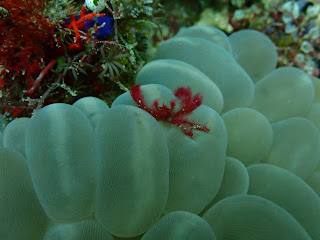Barracuda Point is a world-famous dive site, and it's often top of the wish list for our divers when they make their trip to Sipadan… It's a favourite of our dive staff too - you'll be hard pushed to find a staff member who doesn't rate this amazing place in their top three, if not their number one!
Barracuda Point is in between Drop Off (Turtle Tomb) and Coral Garden, located close to the island. There is a sloping coral reef, which drops down into a channel, with another (smaller) reef rising and then sloping off again before that 600m drop. As the reef takes a sharp corner we get some super fun currents there… There is also a plateau at the end of the channel, which is often where our friends the barracuda can be seen.
We start the dive in the shallows with the jackfish (bigeye trevally) - there are some keyholes (crevices in the reef) where we can see schools of batfish or pickhandle barracudas, a wonderful greeting as you descend after your back roll off the boat! As we cruise in the shallows with the the enormous school of jackfish, very often bluefin trevally and GT's (giant trevally) are around too, looking for prey. We also keep an eye out for the bumphead parrotfish in the shallows – decreased visibility in the shallows is often an indicator that they are there, as they poop out sand – it can get quite murky!

Before we even drop to our max depth, or get to the barracuda tornado it's an awesome dive! We go over the wall and make our way down to our max depth, often passing some white tip reef sharks and huge grey reef sharks on the way. When descending - ALWAYS keep your eye on the blue – as the barracuda sometimes hang out there in a wall of fishy-ness, or sometimes cruise past like a high speed train (we call this getting "buzzed" by the barracuda!).

The wall itself is awesome - with crags and crevices (where we sometimes shelter from the currents to watch the sharks!), but don't forget to look beneath you as we often see turtles resting on the ledges of the wall if they're not swimming overhead. But we don’t stay there, we make our way round to the sloping coral reef on the corner – there’s a beautifully coloured school of red tooth trigger fish and longfin bannerfish mixed together. Watch out for big grey reefs, white tip reef sharks, the barracuda (again) – but also for dogtooth tuna zipping past hunting, or giant groupers hanging out. Watch out for behaviour too – if you see smaller fish schools zipping into the shelter of the reef – look and see what’s chasing and hunting them!

From the outside reef, we make our way back into the channel – sometimes there’s no current, and we get to explore this at our leisure. Spotted garden eels, great barracuda getting cleaned. White tip reef sharks hanging out under corals, or day octopus going about their business. We pass by Turtle Rock – a world-famous cleaning site for turtles (sometimes they fight over who gets cleaned next!) – making our way down the channel nice and easy. If there’s no current, the barracuda form the mesmerising world-famous tornado – almost hypnotic! There's an enormous boulder about halfway down the channel which can have some cool macro finds if you can tear your eyes away from the rest of the action.
But if the current is pumping you can cruise down the channel like Superman! Sometimes we wait it out and fin gently into the current here as the barracuda tornado becomes a wall – no less spectacular, a wall of barracuda as far as you can see! Sighting the tornado or wall of barracuda is top of every diver’s wish list – and the amazing spectacle is what gave this dive site its name.
After we've had enough of the barracuda (as if that is possible!) we can cruise down the channel making our way shallower (keeping an eye out for napolean wrasse) until it's time to make the safety stop… Sometimes the current stops abruptly at the end of the channel, throwing us back where we came from - but that just means you get to see it all over again! And sometimes we cruise on in to the next dive site, Coral Garden. But that's a story for another time…
Safety as always is Scuba Junkie's top priority - so regardless of your experience we'll give you a fantastic dive at Barracuda Point! We know the tides and the conditions really well, and all of our DM's have hundreds (if not thousands) of dives there. Hope to see you soon at Sipadan!!
































